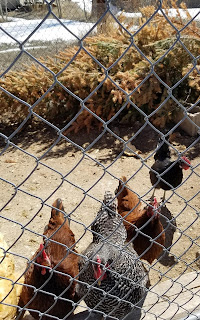Posted by: Todd Hagenbuch, Routt County CSU Extension
 |
| 'The Girls' are so happy the snow has gone; and they love the holiday tree in there for 'fun,' per suggestion of Alison O'Connor's January Co-Horts post. |
That snow has advantages other than providing a surface to ski and snowshoe on and creating storage for water we’ll use this summer; my grandpa always used to say, “That snow covers a lot of work!” But now that the snow has receded, work is being uncovered, and this weekend the Hagenbuch kids got after it.
The first task we handle once a wheelbarrow can navigate the backyard is to clean the chicken coop. We use the ‘deep
litter method’ in our coop, which means over the winter we add fresh shavings every week
or so to keep things clean. Over four of five months of doing this,
we end up with a foot or more of dense litter on the floor of the coop. Not
only does this help us mange the manure we couldn’t otherwise deal with, it also
helps provide a nice layer of insulation to the floor of the coop.
 |
| Look at that beautiful litter! |
Having all of this litter is a real gift for the garden,
given its level of organic material. Others who agree call me and ask if
they can just incorporate litter into their garden, and I’m quick to answer, “NO,
it must be composted first.” This isn’t because it’s too ‘hot’ for your garden,
but instead because it could be introducing bacteria and other unwanted
problems into your garden…and potentially onto the veggies you’ll be eating
this season. No one wants their lettuce to cause anyone to get sick.
Composting or aging chicken litter can be a way to help
reduce the chances of spreading bacteria or disease. The litter also helps
create good microbial action in the compost pile, which might otherwise not
break down as well without the shot of nitrogen it provides. While it’s
challenging to get our compost as hot as I’d like due to our short summers,
cool nights, and long winters, a three-year process helps ensure that things
are broken down well enough to be relatively safe.
 |
| The green arrow shows last year's compost in bin #2; the red arrow is what the kids put in this weekend. |
We have a three-bin compost system, and compost is ‘rotated’ in the fall, right before snow-up. Current year yard waste, veggie waste from the kitchen, and the chicken litter get layered in the first bin; the second bin has the waste from last year that was rotated into it last fall; and the last bin has items from two years ago, breaking down more this summer before it is put into the garden this fall.
Warmer areas of the state can do this process more quickly,
but in the mountains of NW Colorado, I find the ‘go slow’ approach gives me a
much better (and safer) product. I occasionally incorporate some additional
nitrogen into the process in the summer, adding commercially-produced fertilizer
made with Dehydrated Poultry Waste. I will also soak the bins with water a few times each summer
to help break down the materials, especially if we are experiencing a dry
summer.
If you have a coop and are looking for a way to use the litter, take the time necessary to make sure it’s safer for your garden. CSU Extension has good resources on composting, including Fact Sheet #7.212, Composting Yard Waste. Also, if you’re in doubt about the safety of the compost, use it in your flower gardens and forego the potential issues of using it for food-producing gardens. Either way, take advantage of this resource for your yard if you have it.
Oh, and let me know if you enjoyed this blog post, too; that way, I can tell my kids their work this weekend wasn’t just to torture them, but instead an effort that inspired gardeners across Colorado.😉
 |
| Looking good! These clean shavings will be ready to put into the compost bin within the next month or two. |

Thx for this post. We use a 2-bin system for food scraps (we’ve no chickens), so use last year’s compost in this year’s veggie garden.
ReplyDeleteGreat job Hagenbuch kids!! ...and Dad writing in all his free time LOL...
ReplyDeleteGood info! Makes me want to plant a garden!!
ReplyDeleteLove this! Inspiring and useful!
ReplyDelete